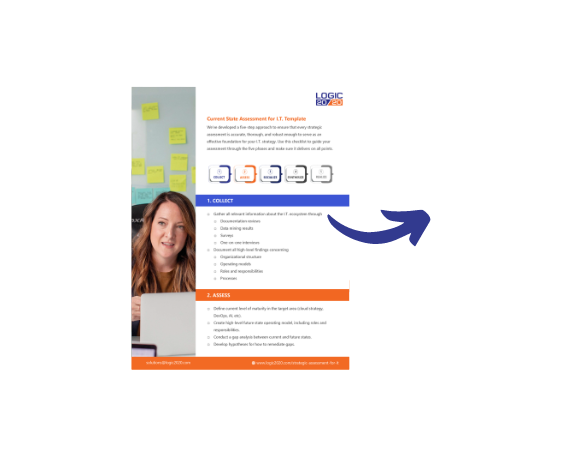Strategic Assessment For I.T.
When your I.T. organization identifies a goal—whether that’s implementing DevOps, incorporating new use cases for AI and machine learning, or moving processes to the cloud—the journey towards that goal starts with determining where things stand today. We call this step the strategic assessment (also called the current state assessment or current state analysis).
Approaching current state assessments from a holistic perspective, evaluating every relevant aspect of your present situation, provides a solid foundation for the strategy that will accelerate your I.T. team towards its goals.
Our Approach
Collect
Gather all relevant information about the I.T. ecosystem and document high-level findings.
Assess
Analyze the current state vs. future state and hypothesize how to remediate gaps.
Socialize
Report findings and hypotheses to stakeholders and finalize operating model for I.T. roadmap planning.
Synthesize
Refine findings, hypotheses, and inputs into detailed recommendations.
Realize
Build an I.T. roadmap based on recommendations and define next steps.
Outcomes
Improved Execution
• Accountable, action-focused I.T. leadership that sets clear expectations
• Data-driven decision making focused on efficiency and accuracy
• An efficient operating model with investments in capacity
• A practice of recognizing both the positive and the negative
Organizational Alignment
• A shared agenda across the whole I.T. organization
• A structure that supports ability to deliver the shared agenda
• Investment priorities that contribute to the I.T. strategy
Return on Investment
• Strong I.T. governance and established support for key initiatives
• Long-term focus on strategy, vision, and communication
• Comprehensive, detailed performance measurements
• An emphasis on continuous improvement, efficiency, and experience
IT Current State Analysis Template
Let our PDF checklist guide you through the five steps of a successful strategic assessment.

What are your challenges? Let’s talk through the solutions.
